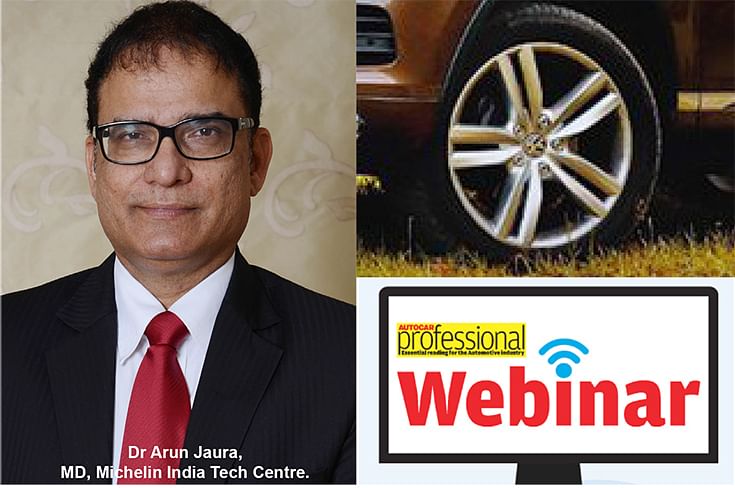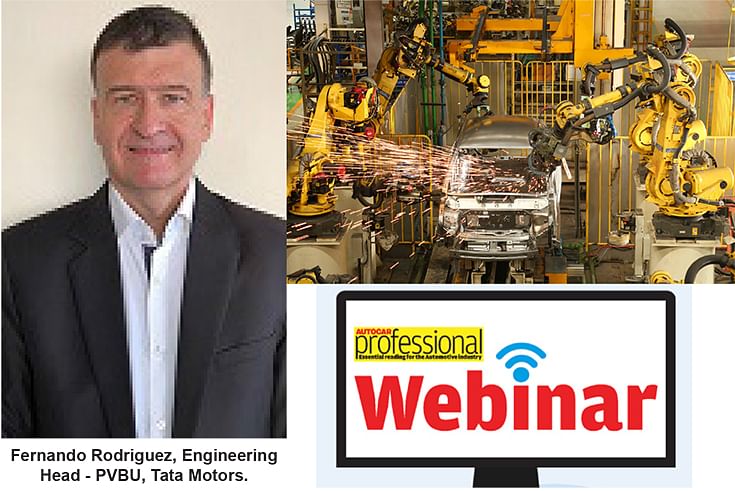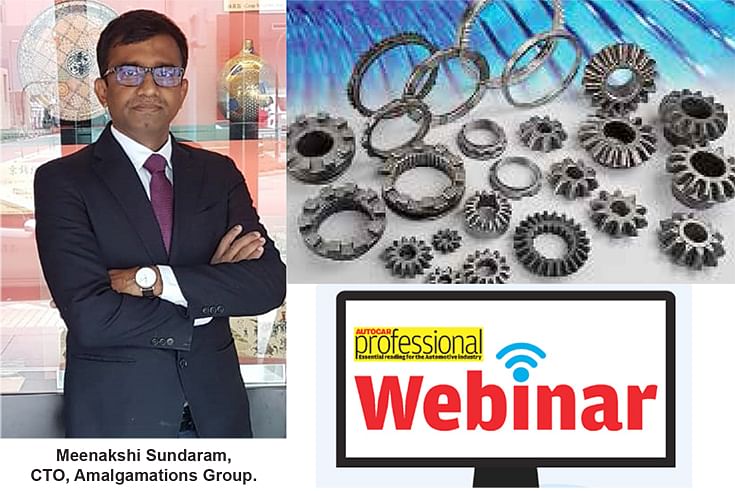India Auto Inc needs greater tech planning, penetration and execution: Experts at Technology Day webinar
According to Industry stalwarts, it is technology alone that can offer a reasonably comprehensive growth strategy while keeping the efficiencies of cost and scale in place.
Technology today is an overriding concept. In a world grappling with the Covid-19 pandemic and the realities of lockdown, technology is almost the cornerstone of excellence in most of our day to day activities. In the automobile industry context as well, technology penetration is one of the fundamental areas of innovation and improvement.
New trends like ride-sharing, lightweighting, connected cars and ADAS are practically driving the auto industry to a precipice of change like never before. The outbreak of the pandemic has surely altered the rules of the game but the broad trend is still on track.

This is exactly why at Autocar Professional, we chose to mark the National Technology Day on May 11 with a webinar on "Pushing the Technology Envelope". The webinar had four top level industry experts shedding light on the need for technology planning and creating the essential roadmap to enable execution with precision and perfection. The panelists comprised:
- Dr Arun Jaura, Managing Director, Michelin India Technology Centre
- Dr Ravi Damodaran, CTO, Greaves Cotton
- F Rodriguez, Engineering Head, Tata Motors
- Meenakshi Sundaram, CTO, Amalgamations Group
The Webinar kicked off at 3 pm and went on for nearly 4:30, moderated by Sumantra B Barooah, executive editor, Autocar Professional, and provided plenty of takeaways for industry stakeholders. It gave a brad purview of the increasingly expanding role of technology in not just enhancing efficiencies of scale but cost as well. For an industry that was anyway in the throes of one of the longest downward spiral, the Covid-19 no doubt put a spanner in the works. But according to the Industry stalwarts who took time out for this webinar, it is technology alone that can offer a reasonably comprehensive growth strategy going forward.
Dr Arun Jaura: “India Auto Inc' dynamics will change hugely and we have to be prepared."

Bringing his expertise from being an industry veteran having worked in Ford Motor Company in Detroit to being the former COO of Mahindra & Mahindra and then the former head of Eaton’s India Technology Centre, Dr Arun Jaura, the managing director of Michelin India Technical Centre, kicked off the webinar with his detailed presentation.
Dr Jaura talked about the new normal initiated by the Covid-19 pandemic and how the industry is going to manage the entire situation in the coming future. He mentioned that the traditional ways of working are going to change dramatically, and the need for safety and avoiding proximity among people are going to bring a phenomenal and unprecedented shift towards technology.
“This is a once-in-a-lifetime event that we are facing right now. Covid-19 will completely change the dynamics of the industry and we have to be prepared for that,” Dr Jaura said.
A digital transformation
According to him, a digital transformation with virtual engineering and simulation will play a key role. Simulation can help companies such as logistics players determine their tyre changing schedules and thus, plan ahead in terms of off-loading, arranging finance and alternative service for customers – in a nutshell, offer the ability to undertake efficient planning.
Moreover, companies would now be looking at merging the online business with offline and do a lot of contactless business. He mentioned that there are services and digital offerings which can allow to pool cargo between different clients to bring out the best system efficiency, while also making the transportation cost-effective for everybody.
“The future of value-creation model is a real challenge. There is going to be a lot of contactless business and businesses with integrated digitalisation options are going to benefit most and be able to survive this tectonic shift,” he explained.
Dr Jaura outlined how the "New normal will see buying power go down and this will last 18-24 months. Operational cost will fall, surface mobility will reduce due to work from home culture. Two-wheelerswill rebound fastest and passenger vehicles and public transport will take time.Last-mile connectivity will grow."
He closing remark did not just set the tone of the webinar but also set out a working plan for the industry as such - “It is not just about pushing the technology envelope but also enhance technology penetration to meet the consumer demand.”
F Rodriguez, Tata Motors: “Safety is going to be one of the technology drivers for the market in future.”

Sharing his vast knowledge on the automotive industry, Fernando Rodriquez, Head – Engineering, Passenger Vehicle Business Unit (PVBU), Tata Motors, spoke on the global and domestic trends that is shaping the automotive segment. Rodriguez has over 50 years of experience in the automotive industry, and has also been with Renault Groupe for over 27 years.
He pointed out that in India, while new technology is appreciated, it has a strong relation with cost. “Historically it was difficult for OEMs (to offer latest technologies) because of the price consciousness in the Indian market.” He said while the scenario still exists in India and is challenging for OEMs to offer newer features/technologies without adding significant cost. “It is a challenging but interesting market,” commented Rodriquez.
Autonomous, Connected, Electric, Shared and safety tech
The technology head said that the global automotive industry is now looking at the megatrend of ACES (Autonomous, Connected, Electric and Shared), “in India there is a need to add the Safety aspect as well”. “Safety consciousness (among consumers) is growing rapidly, in Tata Motors we are proud of what we have done in safety, and are at present leaders and will continue to be leaders in the future as well.”
He points out that for long customers didn’t perceive safety as a value, but it is now changing, and it will become a growing influencer. Autonomous tech is one of the major trends worldwide, but will take time to find demand in the Indian market because of the riding condition, infrastructure and cost of technology, among others.
He remarked that "Connectivity is going to be another key driver of technology. How you communicate will progressively be based more on soft-touch buttons. The concept of connected cars is set to be another key theme to follow for industry, going forward."
Lightweighting and emissions
Rodriquez said that beyond safety and the ACES megatrend, Tata Motors is also “looking at technologies in the area of lightweighting, new materials, BIW, powertrain, it is also about digitisation of engineering process. With digitalisation, which is becoming sharper and more accurate, which allows to set higher target and meet higher customer expectations. By running simulation at system levels (not component), we can have extensive prototype testing, all of this can be optimised, which will allow easier modififcation allowing for the highest accuracy before the first prototype. This enables for more optimised vehicles,” explained Rodriquez.
Speaking on powertrain development, he said that the segment i mainly driven by two factors, legislation and fuel efficiency. Pointing out that in Europe, talks around Euro 7 norms have already started, which means “BS VI is not the final step”. In terms of improving fuel efficiency, he does not just expect changes in the powertrain but the overall vehicle, “Powertrain another area of focus in terms of the growing role of technology. Fuel efficiency is a key theme, not just in terms of the powertrain but complete vehicle fuel efficiency, both to reduce emissions and also to offer better efficiency."
Dr Ravi Damodaran: “Create a technology roadmap and build capabilities to execute it.”

Speaking at the webinar, Dr Ravi Damodaran, Chief Technology Officer (CTO) at Greaves Cotton said, “The best way to come out of any disruption is to have a tech-related roadmap and then follow on it.”
Damodaran, whose current role at Greaves Cotton involves leading the technology development in mobility, energy and farm sector reveal that pushing the technology envelope requires adoption of three key ingredients by a company. The first one is to understand the technology trends and its impact on the company. The second is to create a technology road map and third is to build capabilities to execute the plan.
According to Damodaran, ‘timing’ of execution is very important as successful companies are those which know when a certain technology can be used for mass market. “ Thus creating a sequence of tech innovations that the company wants to get into” Damodaran further added.
Increasing role of technology
Offering an example of Honda Motorcycle & Scooter India (HMSI) which changed the market dynamics with its gearless scooters in India Damodaran remarked, "The Indian two-wheeler industry is a big manifestation of the role technology plays - Honda used its technology power and put a gearless scooter in the market in response to customer needs. And in just 10 years it captured the market." With about 56 percent of total scooter sales in India HMSI currently stands as a market leader in the segment.
Damodaran’s closing comments no doubt kindled a ray of hope for the beleaguered automobile industry, “Need to have a technology roadmap and also the ability to successfully execute it. A pandemic like Covid-19 will only stagger investment not stop pushing the technology envelope.”
Meenakshi Sundaram: 'Differentiating between product value will be the key to winning more customers.'

Meenakshi Sundaram, CTO, Amalgamations Components Group steered the discussion further into the role of technology in creating a winning product. Speaking more about on the topic from a component manufacturer perspective, he said, “For BS VI, we can send our products to the global market. In the motorcycle segment, we are the first in the world to have BS VI and we can lead the market. Be it a small or large enterprise, they can choose to be a leading company or can just become a competition by a player with a price. The customers are not going to pay for requirements anymore and nor necessarily stating the requirements. They are asking us to make the requirements by ourselves. How do we do that? We need to look at a process internally and make sure that we meet the requirements. At the same time, we provide value and bring up the value chain. So benchmarking is one of the steps for the Tier-I companies to look at these.”
According to him, this price-value proposition is crucial. Pointing out an example, he said that a smaller company might want to work with a 90 percent reliable component which has 95 percent confidence. While for the same component, larger companies might work with 95 percent reliable component with 90 percent confidence. Every company would address it differently. At the Amalgamations Group, which makes pistons among a host of components, they have to improve their engineering team for product development. This has to come through technology, and the development process has to be essentially placed inside its organisation. Concept launch, knowledge plan and putting it all together is very essential.
Pillars of technology penetration
He outlines that, “Lightweighting, reduction of friction and efficiency improvement our key focus areas.” Pointing out that the industry is at the crossroads of ICE, EV and hybrids, he stated that they need to ride two horses at the same time. IC engines are going to be around till at least until 2030-40, he said.
Answering a question from a young entrepreneur on what they should be manufacturing in the automobile industry from a new young entrepreneur, the CTO said, “Automotive industry is undergoing a change. There is an ICE improvement, an EV change and both are inevitable. As a small company, they need to know what are the strengths and what are they capable of. They have to do benchmarking on where they stand among the market and should come up with a value proposition to beat their competitions. They have to think about where they are placing the product with what value and price. If all these merge together any product can be made successful.”
Charting a helpful course for the future, he feels one should, “use the current lull to help bounce-back with greater force using the fillip that technology enables.”
All in all, Autocar Professional's webinar was a fine way to end the day, which was also National Technology Day for India.
Fernando Rodriguez: “Safety is going to be one of the technology drivers for the future.”
Dr Ravi Damodaran: “Create a technology roadmap and build capabilities to execute it.”
RELATED ARTICLES
Cosmo First diversifies into paint protection film and ceramic coatings
The Aurangabad, Maharashtra-based packaging materials supplier is leveraging its competencies in plastic films and speci...
JSW MG Motor India confident of selling 1,000 M9 electric MPVs in first year
The 5.2-metre-long, seven-seater luxury electric MPV, which will be locally assembled at the Halol plant in Gujarat, wil...
Modern Automotives targets 25% CAGR in forged components by FY2031, diversifies into e-3Ws
The Tier-1 component supplier of forged components such as connecting rods, crankshafts, tie-rods, and fork bridges to l...






 12 May 2020
12 May 2020
 6558 Views
6558 Views





 Autocar Professional Bureau
Autocar Professional Bureau




